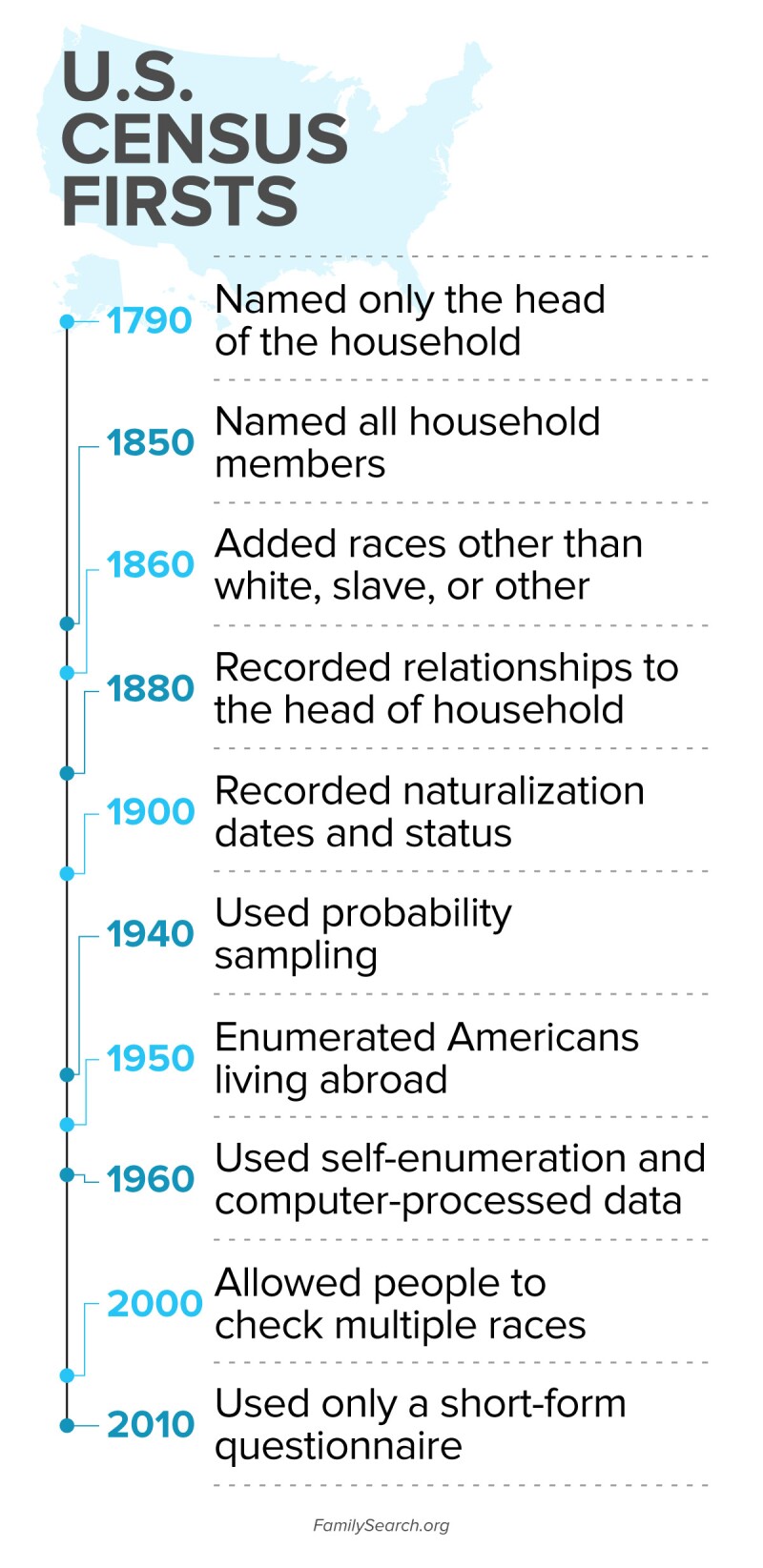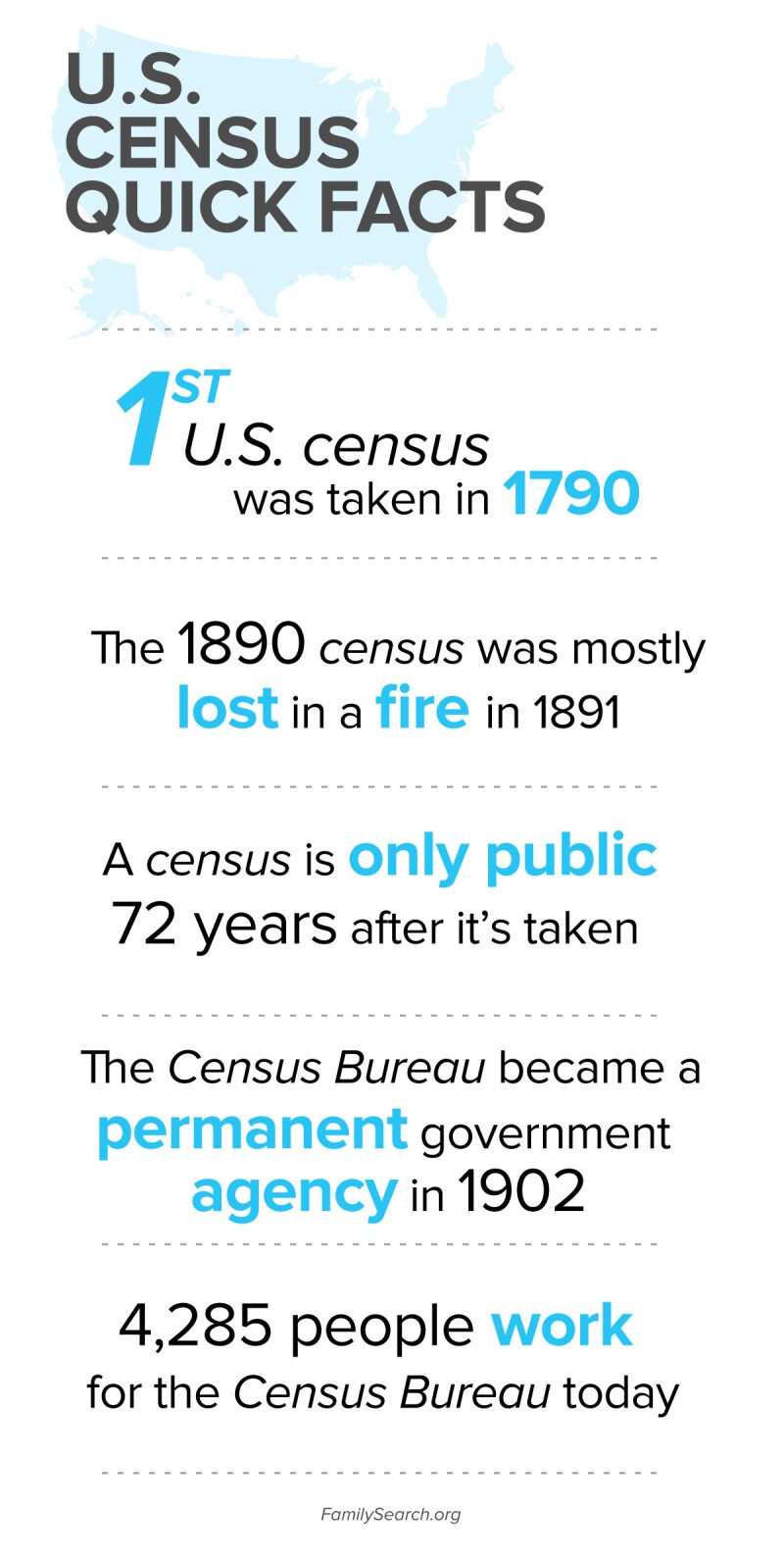Does your family tree have any generations that lived in the United States? If so, FamilySearch’s U.S. census records may help you discover more about your ancestors. Census records are an integral source for family history research; they contain valuable information that can connect generations.
Every 10 years, the United States Census Bureau conducts a national census. Since the first U.S. census was taken in 1790, 23 censuses have been recorded in the United States. Of those 23 census collections, 16 are now available to the public. A census record can tell you not only where and when your ancestor lived, but may also describe their occupation, other members of their household, and even small details about their life, such as previous military service or whether they owned a radio set.
Read More about the U.S. Census Records
Why Is a Census Taken?
One reason a census is conducted is for taxation purposes. However, the impact of a census can be felt at all levels of a community. When a country takes a census, it allows officials to see the growth and change impacting the nation. With this information, a government can see where to allocate federal and state funds. The United States also uses census information to determine the number of representatives each state receives in state and federal legislatures.

Since its first years as a declared nation, the United States has grown significantly in population. If you’re a student of American history, you’re probably familiar with many of the historical and political changes that have contributed to this staggering growth.
In 1790, the U.S. consisted of only 13 states, and the population was already around 3,929,214. Eighty years later, 37 states were considered part of the United States, and the population had risen by over 800 percent. In 1940, when the population was over 132 million, the U.S. was almost at it its current state count (missing only Alaska and Hawaii). By 2010, despite the addition of only two states, the population had increased by more than 150 million from the 1940 figure. This increase meant that in 2010, the United States population was nearly 8,000 percent higher than the population estimated in the first census!
Federal and State Census Records
Historically, two main types of censuses have been taken in the United States: the federal census and state censuses. These two types of censuses were often taken five years apart from each other. However, not every state conducted a state census, and no state has conducted a census since the Massachusetts state census in 1985. By searching both federal and state censuses, you can gather an understanding of where your ancestors lived and who they were.
Search U.S. State Census Records
These state census records can be especially useful in family history research, as some states or territories may not have been completely covered in a federal census or the federal census may have missing information. State census records can be found with a general U.S. records search on FamilySearch.org. The FamilySearch Wiki lists out censuses by state and by year, and it also gives more information about each state's census.
Search U.S. Federal Census Records by Decade
The U.S. federal census changes from year to year, so the census to track patterns in society that your ancestors might've been affected by. Different kinds of information might be available about your family in one decade compared to another. Use the table below to search for your ancestors in each decade of U.S. federal census records.
| 1790 | 1800 | 1810 | 1820 | 1830 | 1840 |
| 1850 | 1860 | 1870 | 1880 | 1890 | 1900 |
| 1910 | 1920 | 1930 | 1940 | 1950 |
Learn More about Each Decade of U.S. Federal Census Records

How Does the United States Census Change?
Questions and recorded information change with each census. These changes most often reflect current events in the country. They can also reflect socioeconomic changes or political changes the country is going through during a decade.
Typically, census records have become more detailed each year. The first United States Census recorded information only about the heads of households—other household members were counted according to gender. Census records since then have added increasingly detailed information on every individual as the country has grown and society has changed.
How censuses are taken has also changed over the years. If you lived in the United States in 1940, you may have been asked to fill out a longer census form than your neighbor. The census takers (enumerators) used a more detailed questionnaire for only a portion of the population. 1960 was the first year the U.S. census was processed almost entirely by computers after it had been gathered.
When you are searching through census records, it can be useful to consider how each year’s records were different and what information might be available in the census records you are viewing.

The 72-Year Rule and Other U.S. Census Quick Facts
A unique rule prevents census records from becoming available to the public until 72 years after the census was taken. This rule helps protect the identity of people enumerated in past censuses who are still living. Currently, all census records are available up to the year 1950.
You can learn other interesting facts about the census as you dig into its history. The United States Census Bureau wasn’t a permanent government agency until 1902. (The secretary of state was in charge of the first censuses.) Many employees and volunteers for various organizations have worked behind the scenes to gather the census record collections and make them searchable. Each census offers a wealth of genealogical information that can connect generations.
United States census records up to 1950 are available for free on FamilySearch.org, and the collections are fully indexed. Every time you do a general records search for one of your ancestors, FamilySearch will search through all the federal censuses from 1790 to 1950, many of the indexed state collections, and other helpful records as well!
At FamilySearch, we care about connecting you with your family, and we provide fun discovery experiences and family history services for free. Why? Because we cherish families and believe that connecting generations can improve our lives now and forever. We are a nonprofit organization sponsored by The Church of Jesus Christ of Latter-day Saints. To learn more about our beliefs, click here.










